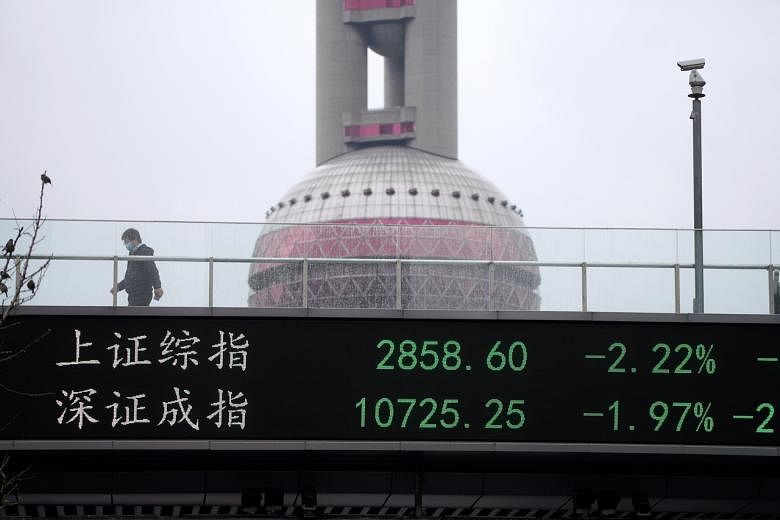SYDNEY (REUTERS, BLOOMBERG) - Asian shares rose on Friday (March 20), US stock futures gained and the US dollar snapped an eight-day rally as investors took stock of massive stimulus measures, giving tentative signs of returning appetite for riskier assets.
In Australia, the S&P/ASX 200 was up 0.7 per cent, off a 4.5 per cent rally in the morning. South Korean stocks, which saw heavy losses on Thursday, surged 7.2 per cent.
Singapore's Straits Times Index was up 1.7 per cent as of 2:50pm local time.
Hong Kong's Hang Seng Index jumped 4.1 per cent in opening trade, while the benchmark Shanghai Composite Index rose 1.6 per cent.
Markets in Japan are closed on Friday for a holiday.
Futures on the S&P 500 Index added 1.1 per cent as of 6:32 am in London. . The index rose 0.5 per cent on Thursday.
As the spread of the coronavirus brought much of the world to a halt, nations have poured ever-more-massive amounts of stimulus into their economies while central banks have showered markets with cheap dollars to ease funding strains. The latest efforts to mitigate the damage include the Bank of England cutting its bank rate to a record low and increasing its bond buying program and the European Central Bank launching a 750 billion euro (S$1.19 billion) debt-buying plan.
Sources told Reuters China was set to unleash trillions of yuan of fiscal stimulus to revive an economy facing its first contraction in four decades.
"The speed and aggression with which authorities are wheeling out measures to cushion the economic fallout from the virus and sewing the seeds for a hopefully rapid recovery, has resonated somewhat in equity markets," said Ray Attrill, head of FX strategy at NAB.
"Yet there is little doubt that funds need to buy dollars to rebalance hedges in light of the 30 per cent fall in equity markets so far this month," he added. "The dollar remains the pre-eminent safe-haven asset during time of extreme market stress."
The dollar was down against most other currencies on Friday after soaring over the past week owing to massive demand for the unit from investors running to safety. It slumped from a record high after a statewide stay-in-place order in California ignited worries that other states may follow suit and push the world's largest economy into recession.
The Australian dollar led Friday's partial recovery among beaten-down majors with a 3 per cent gain to US$0.5897. The pound rose 1.5 per cent rom a 35-year low to US$1.1654.
The yen rose 0.7 per cent to 109.97 per dollar. The South Korean won rallied more than 3 per cent from an 11-year low, amid broader gains in regional stock markets.
The Fed on Thursday had increased access to dollars for central banks in nine countries to ease pressure on the currency. The US central bank said swaps, in which the Fed accepts other currencies as collateral in exchange for dollars, will be in place for at least the next six months.
The swaps will allow the central banks of Australia, Brazil, South Korea, Mexico, Singapore, Sweden, Denmark, Norway and New Zealand to tap a combined total of up to US$450 billion to help ensure the world's dollar-dependent financial system functions.
The collateral to purchase crude oil, for example, is US Treasury debt and to buy those securities requires dollars, said Michael Skordeles, US macro strategist at Truist/Suntrust Advisory Services in Atlanta.
"All these things kind of happening at once causes a lot of dominoes to fall, and as the dominoes fall, it creates more demand, pushing people toward the dollar," Skordeles said.
"This (the dollar swap lines) is going to help, but it's not a silver bullet," he said. "Because there's a flow of capital into dollar-denominated assets, in particular US Treasuries, it's starving these countries of liquidity and making the dollar appreciate."
OIL RALLIES
Oil prices recovered further on Friday, following steep gains in the previous session after US President Donald Trump hinted he may intervene in the price war between Saudi Arabia and Russia at an "appropriate time".
Prices were also supported by United States' plans to buy up to 30 million barrels of crude oil for its emergency stockpile by the end of June, while regulators in the country's largest oil-producing state Texas were reportedly considering curtailing production.
The more active West Texas Intermediate (WTI) crude futures contract for May was up 43 cents, or 1.7 per cent at US$26.34 a barrel by 0540 GMT. The contract rose as much as 5.5 per cent to US$27.34 per barrel earlier in the session.
"An astonishing rebound in crude oil prices overnight was primarily driven by US's consideration to intervene in the oil market by increasing strategic reserves, while slashing some oil production," said Margaret Yang, market analyst at CMC Markets.
"The underlying issue is that global energy demand is falling sharply as more countries join the 'lockdown' club. The severity of Covid-19 for the macro-economy could exceed anyone's expectation, and it could last for a long period of time."
Brent crude futures climbed 28 cents, or about 1 per cent, to US$28.75 per barrel.











